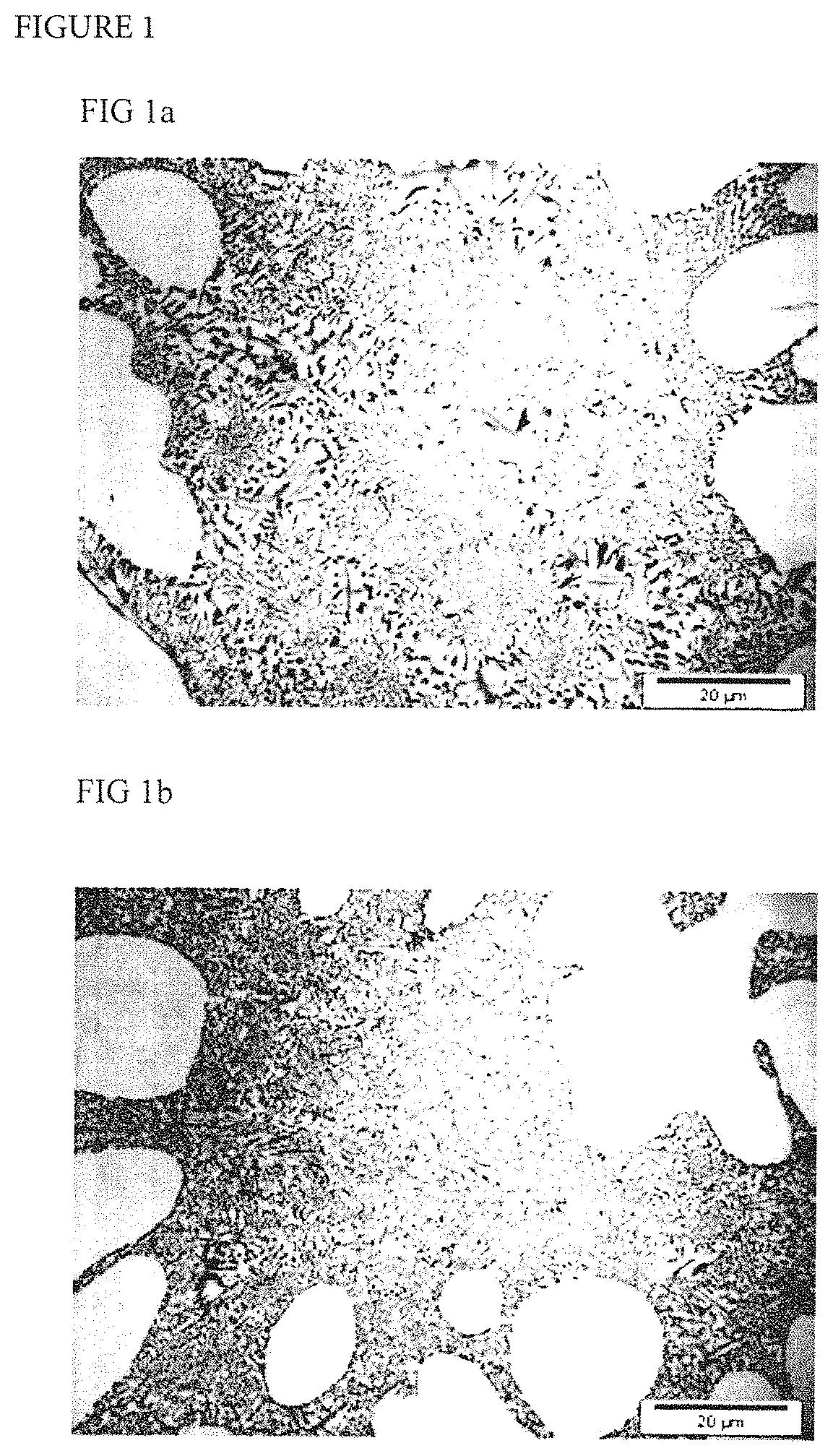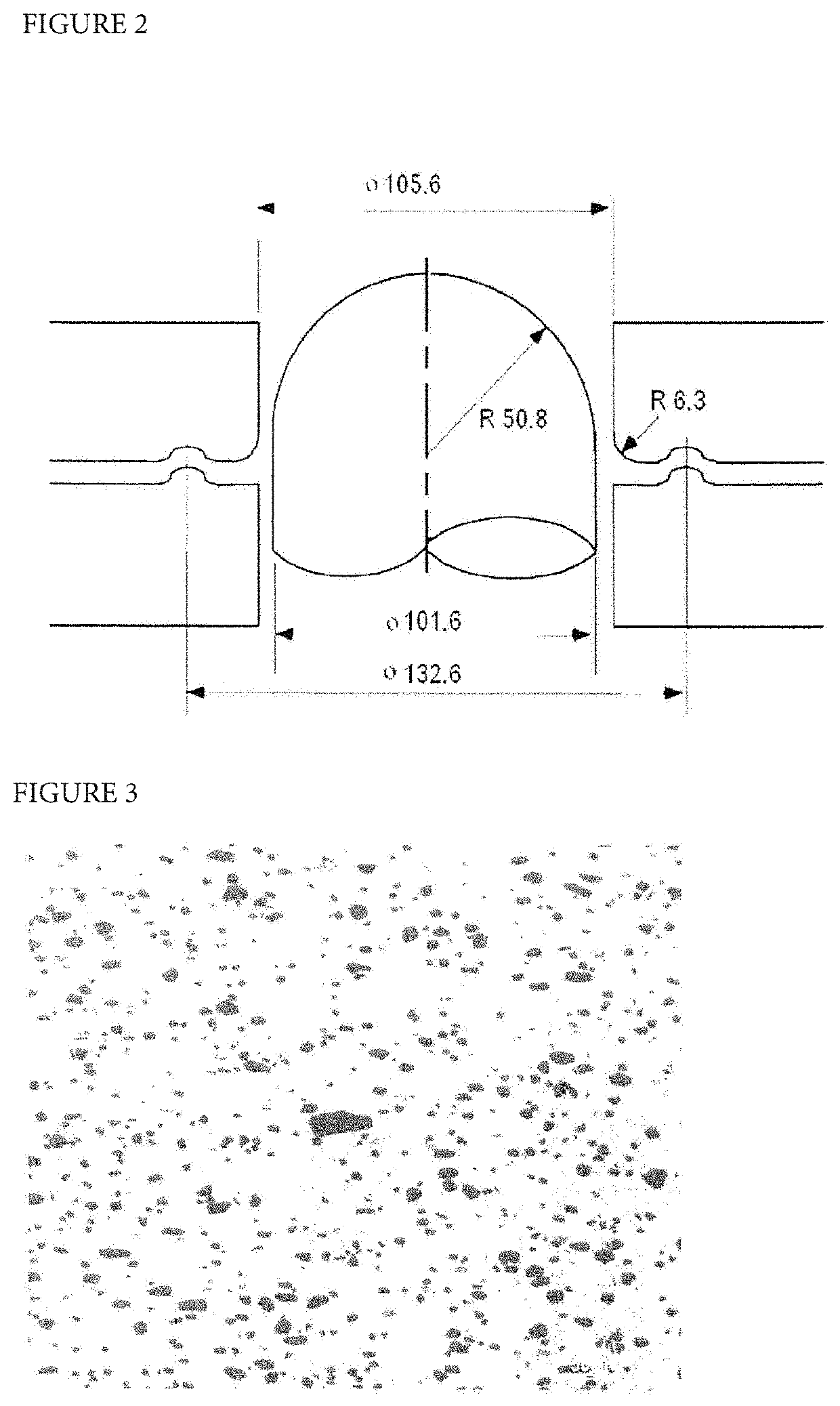Highly rigid sheet for car body
a high-resistance sheet and car body technology, applied in the direction of superstructure, transportation and packaging, vehicle components, etc., can solve the problems of difficult transposition of steel to aluminium for reinforcing parts, especially for inner or structural parts, and difficulty in achieving high-resistance sheets,
- Summary
- Abstract
- Description
- Claims
- Application Information
AI Technical Summary
Benefits of technology
Problems solved by technology
Method used
Image
Examples
example 1
[0093]50 mm thick ingots were cast. Table 1 shows the composition of the ingots.
[0094]
TABLE 1composition of ingots in weight %NoSiFeCuMnMgCrTiSr111.30.260.100.500.050.05211.20.260.100.520.050.050.03312.80.280.110.580.050.050.03415.00.250.100.520.050.01
[0095]The ingots were heated to 540° C. for two hours and were then hot rolled to a thickness of 9 mm and were then cold rolled to a thickness of 3.5 mm. The thin sheets thus obtained were solution heat treated at 540° C. for one minute and then quenched. A heat treatment was then done for 8 hours at a temperature of 85° C. The sheets were then aged at ambient temperature to obtain a T4 temper. A two-hour annealing heat treatment at 210° C. was also carried out on some sheets.
[0096]The cast structures were then observed by optical microscopy. FIG. 1a shows the structure obtained for alloy 1 and FIG. 1B shows the structure obtained for alloy 2. The addition of strontium reduces the size of eutectic compounds that appear in black, which ...
example 2
[0101]50 mm thick ingots were cast. Table 3 shows the composition of the ingots.
[0102]
TABLE 3,composition of ingots in weight %SiFeCuMnMgCrTiSrA12.60.260.000.110.560.020.050.03B12.70.250.030.100.580.020.050.04C12.90.270.100.110.550.020.050.03D12.60.270.000.110.360.020.050.04E12.60.100.000.100.580.020.050.04F12.80.200.040.100.590.020.050.04H12.90.270.100.110.550.020.050.03I12.90.270.100.110.550.020.050.03
[0103]Ingots A to F were heating to 540° C. for two hours and then hot rolled to a thickness of 9 mm with a hot rolling start temperature between 518 and 524° C. and a hot rolling end temperature between 218 and 233° C., then cold rolled to a thickness of 3.5 mm. Ingot H was heated to 460° C. for two hours and then hot rolled to a thickness of 9 mm with a hot rolling start temperature of 451° C. and a hot rolling end temperature of 201° C., then cold rolled to a thickness of 3.5 mm. Ingot I was heated to 500° C. for two hours and then hot rolled to a thickness of 9 mm with a hot roll...
example 3
[0116]A 420 mm thick ingot was cast. Table 6 shows the composition of the ingot.
[0117]
TABLE 6composition of ingots in weight %SiFeCuMnMgCrTiSrJ12.40.150.090.100.140.020.030.03
[0118]The ingot J was heated to 540° C. for more than an hour and was then hot rolled to a thickness of 6.1 mm and then cold rolled to a thickness of 1.5 mm. The thin sheets thus obtained were solution heat treated at 540° C. and then quenched. The sheets were than aged at ambient temperature to obtain a T4 temper. A 20-minute heat treatment at 185° C. preceded by 2% pre-strain was also done on some sheets to simulate baking of car paint.
[0119]The mechanical characteristics were measured according to standards NF EN ISO 6892-1, EN 485-1 and ASTM 1876 along the direction perpendicular to the rolling direction. The dimensions of samples used to measure the modulus E were 60×20×1.5 mm. The coefficient of plastic anisotropy at 10% plastic strain r10 was determined according to ISO standard 10113. The tensile strain...
PUM
| Property | Measurement | Unit |
|---|---|---|
| yield stress | aaaaa | aaaaa |
| yield stress | aaaaa | aaaaa |
| elongation at rupture | aaaaa | aaaaa |
Abstract
Description
Claims
Application Information
 Login to View More
Login to View More - R&D
- Intellectual Property
- Life Sciences
- Materials
- Tech Scout
- Unparalleled Data Quality
- Higher Quality Content
- 60% Fewer Hallucinations
Browse by: Latest US Patents, China's latest patents, Technical Efficacy Thesaurus, Application Domain, Technology Topic, Popular Technical Reports.
© 2025 PatSnap. All rights reserved.Legal|Privacy policy|Modern Slavery Act Transparency Statement|Sitemap|About US| Contact US: help@patsnap.com


